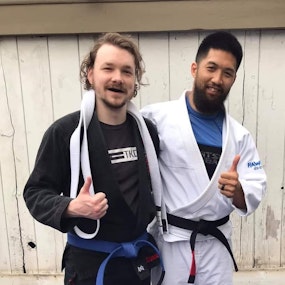Combat Learning is about radically improving you as a teacher and learner of martial arts using the ecological approach to training. We explore the little-known frontiers of skill adaptation, perceptual-motor learning, and human performance science for combat sports.
After teaching martial arts for several years, I realized that most instruction is based on unexamined traditions handed down from one instructor to another. Little to no science or research is ever incorporated…
Hungry to explore ways to improve myself as an instructor, I set off to study educational psychology and motor learning. In that process, I discovered the games-based and constraints-led approaches to coaching, which are radically different methodologies than what I had seen anywhere in my career as a martial artist…
In fact, these methodologies are built around designing practice exercises that allow students to explore the solutions to problems on their own, rather than teaching them solutions directly or having them do lots of technique repetitions–
In other words, games-based and constraints-led methodologies are about playing specialized versions of the game itself instead of doing lots of structured drilling isolated from live play…
Come to find out, there’s a robust and growing scientific literature that shows this type of training, while seemingly messy at first, creates much more powerful learning over time than the traditional repetition-based approach…
But despite these approaches being new, exciting, and even scientific, I was still hesitant to change the way I ran my classes. These hang-ups kept swirling around in my mind:
- How will they know what to do?
- Don’t I need to teach them all the “fundamentals” or “basic” techniques first?
- Couldn’t they more easily get hurt?
- How will they avoid developing bad habits?
- Won’t it take much, much longer to get skilled?
Finally, I decided to ignore those thoughts and take a risk. I started small by designing a game to learn and practice wrist grab escapes. The rules of the game were simple:
Students are each partnered with another student. One student’s goal is to maintain (a) control of both wrists or (b) at least one wrist. The other student’s goal is to escape from both holds, either progressively or all at once. The game resets only when both wrists of the defense player are free from the grasp of the offense player.
I let the students have at it, and I was astonished by the results:
- Students with more traditional instruction on and practice with wrist hold escapes were not necessarily better than new or less experienced students at successfully completing their goals.
- Among students with little to no wrist escape instruction, nearly all the basic wrist escape techniques emerged on their own during the course of these games.
- No injuries occurred (except the occasional raw wrist from being held tightly).
- They had a massively more enjoyable experience practicing this way than the traditional way.
(And that was after only one class segment of trying this game.)
My doubts, fears, and assumptions had been shattered. But here’s why this is truly amazing…
If you don’t know about traditional martial arts programs, wrist releases are usually cut up into about a half dozen or more separate techniques. These techniques are then sprinkled throughout the curriculum of a student’s first 6-12 months of training, as part of their “one step” or self-defense promotion requirements.
Yes, you heard that right:
It takes upwards to an entire year to merely acquire all the basic wrist escape techniques you need before you’ve even really begun to become skilled at breaking or escaping wrist grabs…
On top of that, students rarely practice wrist escapes under realistic pressure or in situations where the wrist grabber can react to escape attempts.
So here’s the sad truth:
It’s embarrassingly common for students to totally freeze or forget what to do when people outside of class – even parents or friends – grab their wrists and yank them around.
Now let this sink in:
My simple game had students rapidly discovering effective release techniques, having 10x more fun, and getting more skilled in 10 minutes of play than most students are with wrist escapes after 12 months of traditional training.
Again, that’s 12 months’ worth of skill packed into 10 minutes!
With that, I never looked back, delving deeper and deeper into non-traditional training methodologies. I created the Combat Learning Podcast to share these powerful ideas with you, too.
